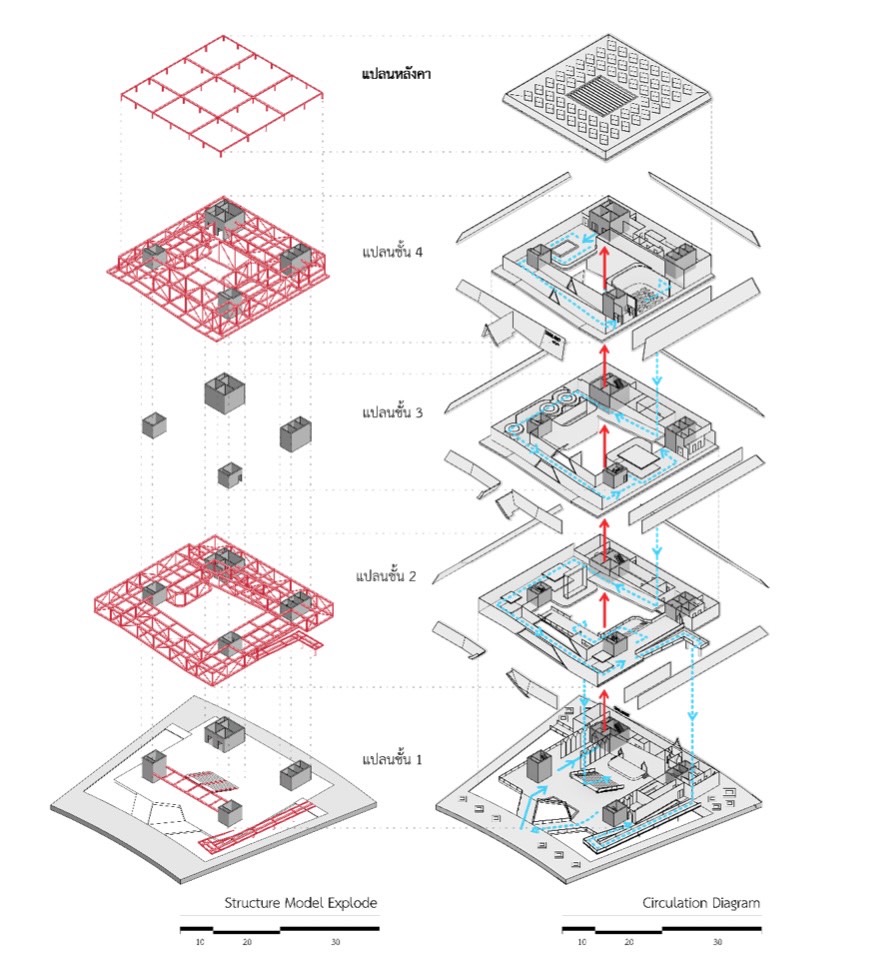Thailand Pavilion Design for World Expo 2020 Dubai
Main Article Content
Abstract
For over 150 years, Thailand has participated in world-class events such as the World Expo. Every event has been presented in association with traditional Thai architecture, reflecting Thai identity in the Thailand Pavilion. In the World Expo 2020 Dubai, the United Arab Emirates, the main theme of the event is “Connecting Minds, Creating the Future.” The objective of this study is to create and present the architecture of Thailand Pavilion to be conformed with the main theme regarding the image of being a modernized nation and in accordance with the policy of Thailand 4.0. The Thailand Pavilion in a contemporary style is appropriate to the high temperature environment of Dubai. It Includes the introduction of innovative technology to be used in both construction and display of exhibition. This research aims to reflect the development and presentation of Thailand through architecture. Thailand Pavilion building in World Expo 2020, Dubai, the United Arab Emirates, covers various aspects regarding fundamentals of Thai architectural identity, the historiography of Modern Architecture in Thailand, Thailand pavilions in the past, building design in high temperature country, and circulation pattern in the exhibition building. It would contribute to the mindsets of all participants and Thai architects in particular regarding the creative architectural design of modern Thailand.
Downloads
Article Details

This work is licensed under a Creative Commons Attribution-NonCommercial-NoDerivatives 4.0 International License.
All material is licensed under the terms of the Creative Commons Attribution 4.0 International (CC-BY-NC-ND 4.0) License, unless otherwise stated. As such, authors are free to share, copy, and redistribute the material in any medium or format. The authors must give appropriate credit, provide a link to the license, and indicate if changes were made. The authors may do so in any reasonable manner, but not in any way that suggests the licensor endorses you or your use. The authors may not use the material for commercial purposes. If the authors remix, transform, or build upon the material, they may not distribute the modified material, unless permission is obtained from JARS. Final, accepted versions of the paper may be posted on third party repositories, provided appropriate acknowledgement to the original source is clearly noted.
References
Asavapitayanont, A. (2010). Energy conservation performance in buildings with tilted envelope in hot-humid climate. Bangkok: Thammasat University.
Digital Economy Promotion Agency Thailand (depa). (2561). Term of Reference (TOR), Procurement of the World Expo 2020 Dubai. Retrieved from https://www.depa.or.th/storage/app/media/TOR-world-expo-2020- dubai.pdf
Expo 2020 Dubai (2016). Self-Build Pavilions Guide. Retrieved from https://www.paih.gov.pl/files/?id_plik=35181
Fusinpaipoon, C. (2016). The Historiography of Modern Architecture in Thailand. (NAJUA), 13(2016), 154-173.
Givoni, B. (1994). Passive and Low Energy Cooling of Buildings. New York: Van Nostrand Reinhold Publishing.
Horayangkura, V. (2014). The creation of Thai identity in architecture. Bangkok: Thammasat University.
Horayangkura, V., Sethaworakit, B., Tengkaoprasert, R., & Inpuntung, V. (2015). Fundamentals of Thai architectural identity. Bangkok: Thammasat University.
Hilary Ballon, Luis E. Carranza, Neil Levine, Pat Kirkham, Scott W. Perkins, Nancy Spector, & Joseph M. Siry. (2009). The Guggenheim: Frank Lloyd Wright and the Making of the Modern Museum. London: Guggenheim Museum Publishing.
Katerina Gordon. (2012). En Construcción: Centrius / Trianera de Arquitectura, ArchDaily. Retrieved from https://www.archdaily.co/co/02-164048/en-construccion-centrius-trianera-de-arquitectura
Prakitnontakan, C. (2006). Social and political in architecture: From Old-Siam to New-Thai during 1892-1947 A.D. (NAJUA), 34-49.
Rattanakosin Exhibition Hall. (2010). Retrieved from http://www.nitasrattanakosin.com
Solomon R. Guggenheim Museum in New York (2017). Retrieved from https://www.unitedwayofnorthernnewyork.org/%e0%b8%8a%e0%b8%a7%e0%b8%99%e0%b9%80%e0%b8%97%e0%b8%b5%e0%b9%88%e0%b8 %a2%e0%b8%a7-solomon-r-guggenheim-museum-%e0%b8%93-%e0%b8%a1%e0%b8%ab%e0%b8%b2%e0%b8%99%e0%b8%84%e0%b8%a3%e0%b8%99%e0%b8%b4/
Sookwong, N. (2020). Integration of Contemporary Thainess in Architecture from ASA Journal. Bangkok: Silpakorn University, 35-47.
Sustainable Building - Design Manual: Sustainable Building Design Practices Paperback. (2009). The Energy and Resources Institute (TERI) Publishing.
Tengkaoprasert, R., Sethaworakit, B., & Horayangkura, V. (2015). Green Architecture and Sustainable Development. Bangkok: Thammasat University.
Thailand Convention & Exhibition Bureau (Public Organization). (2011). 150 years of Thai science and art at the World Expo. Bangkok: WPS (Thailand) Company Limited Publishing.
Yimprayoon, C. (2016). Review Article: Zero Energy Building. Bangkok: Kasetsart University.

